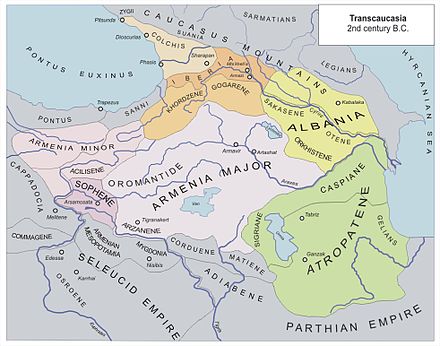This is an old revision of this page, as edited by Valarkho (talk | contribs) at 02:05, 10 June 2021. The present address (URL) is a permanent link to this revision, which may differ significantly from the current revision.
Revision as of 02:05, 10 June 2021 by Valarkho (talk | contribs)(diff) ← Previous revision | Latest revision (diff) | Newer revision → (diff) Ancient Scythian tribe

The Gelae (Template:Lang-grc, Γέλαι, or Γέλοι, Gélai or Géloi ), or Gelians, were a Scythian tribe mentioned by Strabo and other ancient writers as living on the northern slopes of the Caucasus mountains. Others claim the name of the province might possibly be derived from Gilan.
Classical sources
Strabo writes, "The Amazons, are said to live in the mountains above Albania. Now Theophanes, who made the expedition with Pompey and was in the country of the Albanians, says that the Gelae and the Legae, Scythian people, live between the Amazons and the Albanians, and that the Mermadalis river flows there, midway between these people and the Amazons. But others, among whom are Metrodorus of Scepsis and Hypsicrates, who themselves, likewise, were acquainted with the region in question, say that the Amazons live on the borders of the Gargarei, in the northerly foothills of the Caucasian Mountains which are called Ceraunian."
Pliny considers the Gelae and the Cadusii to be synonymous, with "Cadusii" being the tribe's name in Greek, and "Gelae" being its eastern equivalent. If he is correct, then it is likely that the name of modern Gilan is derived from the Gelae.
Recent scholarship
Modern scholars have developed various hypotheses about the original location, ethnicity, and the language of the Gelae. Julius von Klaproth, Pëtr Butkov, Karl Koch, Evgeny Krupnov, Foma Gorepekin, and others, state that Strabon's Gelae are in fact the North Caucasian Galgai (Ingush), and consider the river Mermadalis to be the river Terek, and locate the Gelae in the vicinity of mount Kazbek. Peter von Uslar writes, "traces of the name of Gelae can be found in northern Dagestan". The connection between the name of Gilan and the Gelae was further discussed by Vasily Bartold and E.A. Grantovsky, who accept Pliny's identification of the Gelae and Cadusii as one people who spoke an ancestral form of the Talysh language, one of the Iranian languages.
References
- Strabo, Geographica, xi. pp. 508, 510.
- Plutarch, "The Life of Pompeius", c. 35.
- Ptolemy, Geographia.
- ^ Dictionary of Greek and Roman Geography, vol. I, p. 986 ("Gelae").
- Pliny, Historia Naturalis, vi. 16. s. 18.
- J.Klaproth. Travels in the Caucasus and Georgia. Performed in the Years 1806 and 1808.
- E.Krupnov. Medieval Ingushetia (1971)
- Karl Koch. Reise Durch Russland Nach Dem Kaukasischen Isthmus In Den Jahren 1836, 1837, Und 1838.
- Peter von Uslar, "The Lak Language".
Bibliography
- Strabo, Geographica.
- Lucius Mestrius Plutarchus (Plutarch), Lives of the Noble Greeks and Romans.
- Claudius Ptolemaeus (Ptolemy), Geographia.
- Dictionary of Greek and Roman Geography, William Smith, ed., Little, Brown and Company, Boston (1854).
- Peter von Uslar, Этнография Кавказа. Языкознание. IV. Лакский язык (Ethnography of the Caucasus, vol. IV: "The Lak Language"), Tbilisi (1890).
- Kamilla Trever, "Albania in the IV–II Centuries BCE", in Essays on the History and Culture of Caucasian Albania: IV Century BC–VII Century AD (1959).
- "Onomastics and Epigraphy of Medieval Eastern Europe and Byzantium" (1993), p. 204.
- Naturkunde: Lateinisch-Deutsch, Buch VI, Kai Brodersen, ed., Zürich (1996), p. 184.
- A.K. Alikberov, "To the Sources and Historical Foundations of the Koranic story about Yl'juj, Ma'juj and Zu-l-Karnain", in Ars Islamica: In Honor of Stanislav Mikhailovich Prozorov, Nauka, Moscow (2016), p. 350.
External links
Cadusii, at Encyclopædia Iranica.
Categories: